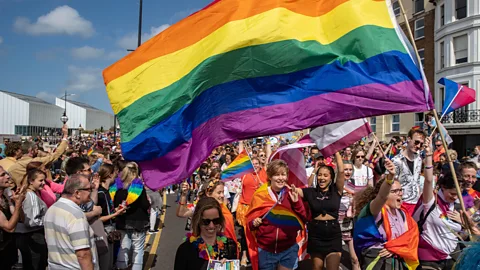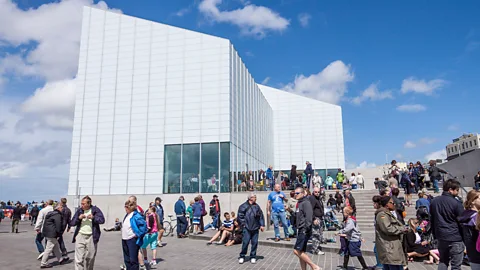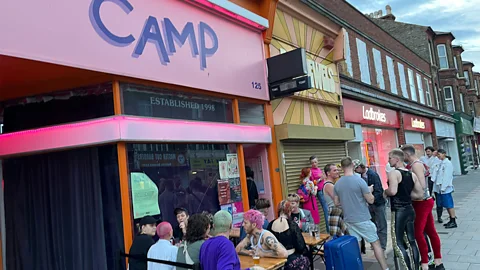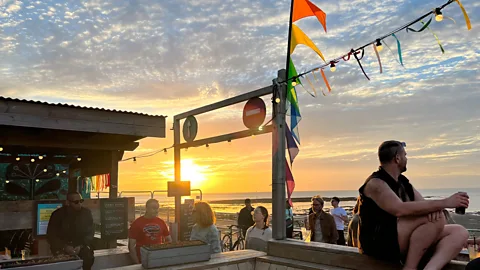Margate: England's unassuming LGBTQ+ hub
 Alamy
AlamyOnce a rundown seaside town, this relatively small coastal resort has blossomed into one of the country's most exciting queer hubs.
As a gay man born in the English coastal town of Margate, in East Kent, I've often pondered the appeal of seaside resorts for queer people. Whether it's the fantasy of greater acceptance levels, a higher tolerance for debauchery or simply the romantic notion of a harbour sunset, LGBTQ+ people have long been drawn to these heady pleasure zones.
In the latest Census, 10.73% of residents in the UK's long-running queer coastal capital, Brighton, identified as LGBTQ+, and 7.09% of residents in Margate's Cliftonville West neighbourhood did too – which is higher than queer-forward English cities like Manchester (6.67%) and Bristol (6.07%). Yet, Margate isn't the only unassuming coastal hub with a rising LGBTQ+ community: others on the south coast include Hastings and St Leonards-on-Sea in East Sussex (8.02% and 7.61%, respectively) and Bournemouth in Dorset (8.96%).
Margate's annual Pride weekend in August attracts more than 15,000 people each year. It's a laidback affair: the day begins at the Oval Bandstand, a restored Victorian amphitheatre on the chalk cliffs above Walpole Bay, followed by a joyously friendly and colourful seafront parade. Unlike bigger events in Brighton or London, it's non-commercial and community-run.
Yet it's sobering to remember that the festival's genesis was anti-LGBTQ+ sentiment. "A group got together nine years ago following a series of homophobic incidents," said co-founder Amy Redmond. "We knew there's power in taking to the streets with cardboard banners, and that same DIY community-focused ethos remains, even though it's doubled in size each year."
 Alamy
AlamyA key component of the event is Margate Black Pride, founded by Brazilian-born art curator Gaëtan Gauthier, who relocated here a decade ago. "It's an opportunity for LGBTQ+ individuals of black and brown descent to join together and march in solidarity, highlighting our intersectional experiences and identities," he said.
But how did Margate reach this apparently tolerant point?
Often called "the original seaside", Margate is one of the UK's oldest coastal resorts, dating to the 18th Century when visitors flocked here to bathe for health reasons. It's synonymous for many with Dreamland, the Grade I-listed Shell Grotto and iconic boundary-pushing local artist Tracey Emin. Yet, its longest-running gay bar, Sundowners, only opened in 2003. In fact, the town's queer history is neither as deep-rooted nor as well-documented as Brighton's, which can be traced to the early 19th Century.
However, certain parallels exist. "The seaside has historically held a special allure for queer communities," said Gaulthier. "It's an escape from the constraints and prejudices of urban life, where individuals can express themselves without fear of judgment or discrimination, and close-knit seaside communities foster a sense of belonging and camaraderie. There's often a rich history of artistic and bohemian culture too, which attracts those who value creativity, diversity and non-conformity, and may feel marginalised in more traditional settings."
 Alamy
AlamyThis is true in Margate, and especially in Cliftonville, a mile or so uphill from the cobbled streets of the Old Town. When I grew up here in the 1980s, its main thoroughfare, Northdown Road – built a century ago as Margate's most fashionable quarter – was a perfunctory shopping stretch. After falling on hard times in the 1990s, it's been reinventing itself in the last 15 years, although Margate as a whole is still one of the most deprived areas in the country. The catalyst for much of this change was the launch of the harbourside Turner Contemporary gallery in 2011, which inspired creatives – often East London transplants – to take over derelict studios and shops across town.
"Commercial and residential rents were cheap," said Lisa Richards, who opened seafront pizzeria GB Pizza in 2012. "There was the buzz of the recently opened Turner, arty types setting up studios and embedding themselves in the local community, and loads of queer folk. Shops were empty, the high street was on its knees, but it felt like anything was possible and people were keen to support anyone that was giving it a go."
Cliftonville became the go-to because "it was the cheapest area to live back then", Richards said. "But my goodness, it had good bones. And glorious beaches."
"Very often queer people move to areas that are seen as deprived because we see potential," added Redmond. "To me, Cliftonville has always been beautiful, ever since I moved here in 2013."
 Alamy
AlamyThat year Redmond, better known by her drag name Amy Zing, opened the pioneering queer and "femme-focused" Margate Arts Club on Northdown Road, which throws diverse and inclusive events like the legendary Cockles and Muscles. But as she modestly maintains, "We're just a small part – and yet so proud to have brought this space to town."
Meanwhile, South African-born Derek Du Preez, who moved to the area in 2019, is one of five owners of nearby neighbourhood bar CAMP Margate, which opened in 2022 and hosts everything from open mic nights to pop quizzes and queer panel discussions. "A handful of trailblazers got here first and slogged away for years before we arrived," he said. "But a big differentiator [in Margate] is that most events are led by women and/or the trans community. People are invested in the community in a way I never experienced in London and show up and support each other. This is the first time I've had a queer support network of neighbours."
Like other coastal communities, Richards suggested that LGBTQ+ people are drawn to places like Margate because of their liminal nature. "It's about living on the edge of society – metaphorically and physically. I think end-of-the-line places attract the bohemians and romantics and artists and, of course, the queers. The artist and queer community are so intertwined that the two often live side-by-side."
"There's something quite camp – excuse the pun – about British seaside towns," Du Preez added. "There's a charm queer people can relate to. These places are diamonds in the rough – often misunderstood, been through some highs and lows – but with lots of potential. Equally, I think LGBTQ+ [people] have a strong connection with the sea and nature – we're all looking for a bit of peace in what can often be quite a brutal existence, and there's something about the seaside that brings us a little bit of that every day."
 Stephen Emms
Stephen EmmsGaulthier offered a note of caution for transplants and long-term visitors. "There can be unintended consequences, such as driving up housing prices and contributing to the displacement of longtime residents. While the presence of new communities injects economic activity, it's a double-edged sword. Balancing the benefits with the preservation of the local community's identity and affordability remains a challenge."
One way visitors can help the community is to support a mix of independent local businesses, from the longstanding, such as Bachelor’s Patisserie, bakers for half a century, and acclaimed diner The Dalby Cafe, which has served enormous fry-ups since World War Two, to the latest happenings. For LGBTQ+ visitors, Du Preez recommends the buzzy brunch stop Wilde's, the roastery We Are Here Coffee and Solstice Studios for – yes – pole-dancing classes. Gauthier is a fan of Queer Run Margate, a weekly event bringing together members of the LGBTQ+ community for social walks or runs. And Redmond suggests Okie Poké for lunch and Cliftonville hair salon Sister Joan.
"A lot of British seaside towns, including this one, have suffered from a lack of funding and support from the government and are some of the most deprived areas in the country," said Richards. "Luckily, the regeneration here has been arts and queer-led, and there's always been a real conversation taking place about how we include all communities in the gains and progress."
Every August, as the annual Pride march finishes in the late afternoon, crowds gather on Sundowners' seafront terrace to party and watch the sunset (Margate is famous for its ever-changing light) before dispersing across its myriad venues.
 Stephen Emms
Stephen Emms"There's something fabulous and camp about this town," said Redmond. "But the fact that we now have a thriving Pride and community, with many queer venues and businesses, has well and truly put it on the LGBTQ+ map."
--
If you liked this story, sign up for The Essential List newsletter – a handpicked selection of features, videos and can't-miss news, delivered to your inbox twice a week.
